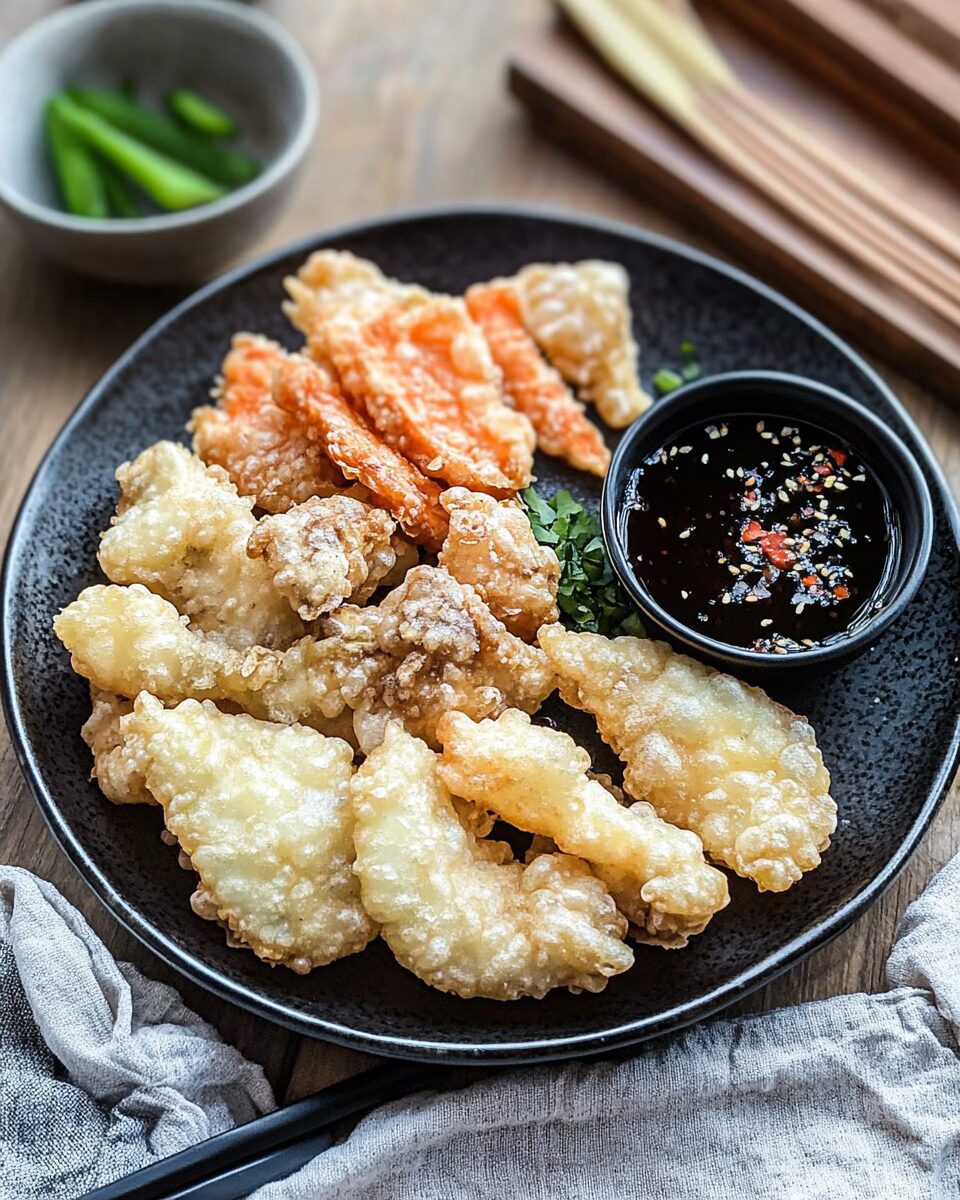Mixed Vegetable Tempura is a classic Japanese dish featuring a variety of vegetables coated in a light, crispy batter and deep-fried to perfection. Paired with a savory homemade dipping sauce, this appetizer offers a delightful combination of textures and flavors that will tantalize your taste buds.
FULL RECIPE:
Ingredients
- For the Tempura:
- 1 red bell pepper
- 1 sweet potato
- 100g oyster mushrooms
- 8 asparagus spears
- 1 cup all-purpose flour
- 1 tablespoon cornstarch
- 1 teaspoon baking powder
- 1 cup cold sparkling water
- Vegetable oil, for frying
2. For the Dipping Sauce:
- 1/2 cup soy sauce
- 2 tablespoons mirin
- 1 tablespoon rice vinegar
- 1 teaspoon spicy sesame oil (or regular sesame oil for a milder flavor)
Directions
- Prepare the Vegetables: Slice the red bell pepper into strips. Peel the sweet potato and cut into thin rounds. Trim the ends of the asparagus spears. Clean the oyster mushrooms and separate them into individual pieces.
- Make the Batter: In a large mixing bowl, combine the all-purpose flour, cornstarch, and baking powder. Gradually whisk in the cold sparkling water until the batter is smooth and slightly runny.
- Heat the Oil: Pour vegetable oil into a deep frying pan or pot, ensuring it’s deep enough to submerge the vegetables. Heat the oil to 350°F (175°C).
- Fry the Vegetables: Dip each vegetable piece into the batter, allowing any excess to drip off. Carefully place the battered vegetables into the hot oil, frying a few pieces at a time to avoid overcrowding. Fry until golden and crispy, approximately 2-3 minutes per side. Remove the vegetables using a slotted spoon and place them on a paper towel-lined plate to drain excess oil.
- Prepare the Dipping Sauce: In a small bowl, mix together the soy sauce, mirin, rice vinegar, and spicy sesame oil until well combined.
- Serve: Arrange the tempura vegetables on a serving platter. Serve immediately with the dipping sauce on the side.
Nutrition Facts
- Serving Size: 1 piece (40g)
- Calories: 53
-
Total Fat: 3.8g
- Saturated Fat: 0.3g
- Trans Fat: 0.1g
- Polyunsaturated Fat: 2.4g
- Monounsaturated Fat: 0.9g
- Cholesterol: 3.8mg
- Sodium: 3.5mg
-
Total Carbohydrates: 4.2g
- Dietary Fiber: 0.7g
- Sugars: 0.9g
- Protein: 0.8g
- Potassium: 68.6mg
Why You’ll Love This Recipe
This Mixed Vegetable Tempura recipe is not only easy to prepare but also versatile. You can use a variety of vegetables, making it an excellent way to incorporate seasonal produce into your meals. The combination of different vegetables creates a variety of textures and flavors, from the sweetness of bell peppers to the earthiness of mushrooms and the crispness of asparagus. The batter provides a light crunch without overpowering the natural taste of the vegetables, allowing their flavors to shine through. One of the best things about tempura is that it is incredibly customizable. You can experiment with different vegetables based on what you have available. Common choices include zucchini, eggplant, sweet potatoes, and green beans.
Tips for Making the Best Tempura
Achieving the perfect tempura requires attention to a few essential techniques. First, the batter should be made using ice-cold sparkling water, which helps create a light and airy texture. The carbonation in the water contributes to the crispness of the tempura, making it delicate rather than heavy. Additionally, it is important not to overmix the batter; a few lumps are perfectly fine, as overmixing can develop gluten, resulting in a chewy rather than crispy texture. The temperature of the oil is another crucial factor. If the oil is too hot, the batter will burn before the vegetables are fully cooked. If it is too cold, the tempura will absorb excess oil and become greasy.
The Importance of the Dipping Sauce
A good tempura dish is incomplete without a flavorful dipping sauce. This recipe includes a homemade dipping sauce made with soy sauce, mirin, rice vinegar, and sesame oil. The combination of salty, sweet, and slightly tangy flavors enhances the taste of the tempura without overpowering it. The dipping sauce can be adjusted to suit personal preferences; for example, adding grated daikon radish or a touch of ginger can provide a fresh and slightly spicy element. Some variations of tempura sauce include dashi-based versions, which incorporate Japanese fish stock for an extra depth of umami. Others may add a hint of sugar or honey for a slightly sweeter taste. For those who enjoy a spicier kick, a small amount of chili oil or wasabi can be added to the sauce. The versatility of the dipping sauce allows for different flavor profiles, making it easy to customize to your liking.
Pairing and Serving Suggestions
Mixed Vegetable Tempura is best served fresh and hot, making it an excellent appetizer or side dish for a Japanese-inspired meal. It pairs well with a variety of dishes, including sushi, miso soup, and rice bowls. Tempura can also be enjoyed as part of a tempura donburi, where the crispy vegetables are placed over a bowl of steamed rice and drizzled with a savory sauce. For a more traditional Japanese dining experience, tempura is often served with a side of grated daikon radish, which helps balance the richness of the fried batter. A simple salad with a light sesame dressing can also complement the dish, providing a refreshing contrast to the crispy tempura. Additionally, tempura can be used in sushi rolls, adding an extra layer of crunch and flavor to the roll. When it comes to beverages, tempura pairs well with light and refreshing drinks.
Healthier Alternatives and Dietary Modifications
While traditional tempura is deep-fried, there are ways to make it slightly healthier without sacrificing its signature crispiness. Using an air fryer can reduce the amount of oil needed while still achieving a crispy texture. Simply coat the vegetables in a thin layer of batter and lightly spray them with oil before air frying at a high temperature. Another option is to use a shallow frying method, which requires less oil than deep frying. For those following a gluten-free diet, the all-purpose flour in the batter can be replaced with a gluten-free flour blend or rice flour. Rice flour, in particular, works well for tempura as it helps create a light and crispy texture similar to traditional wheat-based batter.
Conclusion
Mixed Vegetable Tempura is a delightful dish that showcases the beauty of simplicity in Japanese cuisine. With its light and crispy texture, vibrant assortment of vegetables, and flavorful dipping sauce, it is a dish that appeals to a wide range of palates. Whether served as an appetizer, a side dish, or even as part of a larger meal, tempura adds a satisfying crunch and a burst of flavor to any dining experience. Making tempura at home may seem intimidating at first, but with a few essential techniques, it becomes a straightforward and enjoyable cooking process.






